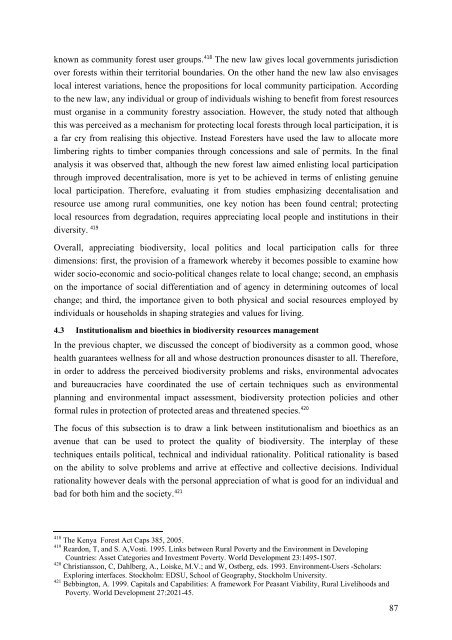THE UNIVERSITY OF LEIPZIG
THE UNIVERSITY OF LEIPZIG
THE UNIVERSITY OF LEIPZIG
Create successful ePaper yourself
Turn your PDF publications into a flip-book with our unique Google optimized e-Paper software.
known as community forest user groups. 418 The new law gives local governments jurisdiction<br />
over forests within their territorial boundaries. On the other hand the new law also envisages<br />
local interest variations, hence the propositions for local community participation. According<br />
to the new law, any individual or group of individuals wishing to benefit from forest resources<br />
must organise in a community forestry association. However, the study noted that although<br />
this was perceived as a mechanism for protecting local forests through local participation, it is<br />
a far cry from realising this objective. Instead Foresters have used the law to allocate more<br />
limbering rights to timber companies through concessions and sale of permits. In the final<br />
analysis it was observed that, although the new forest law aimed enlisting local participation<br />
through improved decentralisation, more is yet to be achieved in terms of enlisting genuine<br />
local participation. Therefore, evaluating it from studies emphasizing decentalisation and<br />
resource use among rural communities, one key notion has been found central; protecting<br />
local resources from degradation, requires appreciating local people and institutions in their<br />
diversity. 419<br />
Overall, appreciating biodiversity, local politics and local participation calls for three<br />
dimensions: first, the provision of a framework whereby it becomes possible to examine how<br />
wider socio-economic and socio-political changes relate to local change; second, an emphasis<br />
on the importance of social differentiation and of agency in determining outcomes of local<br />
change; and third, the importance given to both physical and social resources employed by<br />
individuals or households in shaping strategies and values for living.<br />
4.3 Institutionalism and bioethics in biodiversity resources management<br />
In the previous chapter, we discussed the concept of biodiversity as a common good, whose<br />
health guarantees wellness for all and whose destruction pronounces disaster to all. Therefore,<br />
in order to address the perceived biodiversity problems and risks, environmental advocates<br />
and bureaucracies have coordinated the use of certain techniques such as environmental<br />
planning and environmental impact assessment, biodiversity protection policies and other<br />
formal rules in protection of protected areas and threatened species. 420<br />
The focus of this subsection is to draw a link between institutionalism and bioethics as an<br />
avenue that can be used to protect the quality of biodiversity. The interplay of these<br />
techniques entails political, technical and individual rationality. Political rationality is based<br />
on the ability to solve problems and arrive at effective and collective decisions. Individual<br />
rationality however deals with the personal appreciation of what is good for an individual and<br />
bad for both him and the society. 421<br />
418<br />
The Kenya Forest Act Caps 385, 2005.<br />
419<br />
Reardon, T, and S. A,Vosti. 1995. Links between Rural Poverty and the Environment in Developing<br />
Countries: Asset Categories and Investment Poverty. World Development 23:1495-1507.<br />
420<br />
Christiansson, C, Dahlberg, A., Loiske, M.V.; and W, Ostberg, eds. 1993. Environment-Users -Scholars:<br />
Exploring interfaces. Stockholm: EDSU, School of Geography, Stockholm University.<br />
421<br />
Bebbington, A. 1999. Capitals and Capabilities: A framework For Peasant Viability, Rural Livelihoods and<br />
Poverty. World Development 27:2021-45.<br />
87






